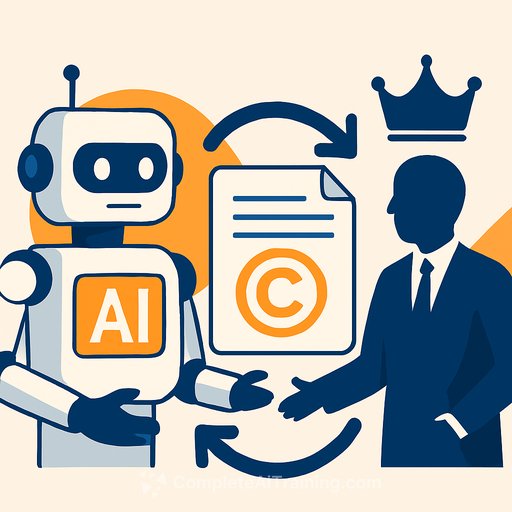Confronting Empty Humanism in AI Policy: From Slogans to Enforceable Outcomes
AI debates swing between dehumanizing hype and lofty promises of "human flourishing." The first is alarming; the second is comforting. Both can be used to defend the status quo. The real work is translating values into enforceable policy that protects people and public institutions.
Why "human-centered" talk gets co-opted
Politicians and companies deploy language about dignity, freedom, and opportunity because it polls well and lowers public concern. Executive orders, safety pledges, and corporate manifestos repeat the same words while advancing deregulation or narrow commercial gains. Agencies follow suit with soft-law and "human-in-the-loop" taglines that sound protective but change little. Rhetoric is cheap; outcomes are scarce.
When "human-in-the-loop" becomes a rubber stamp
Human oversight can fail if people are asked to bless decisions they cannot understand, question, or reverse. Without time, authority, or training, oversight is theater.
- Define decision rights: who can pause, override, or reject an AI output.
- Guarantee appeal: clear, fast, human-led redress with documented reasons.
- Resource it: staffing ratios, training, and time budgets so oversight is real.
- Set triggers: auto-escalation for high-risk cases; mandatory second reviews.
- Track and publish: override rates, error types, and fixes.
The "AI race" and national security cover
War and race metaphors justify speed and secrecy while sidelining scrutiny. They also help domestic lobbying for fewer rules under the banner of "don't let the bad guys win." Security matters, but it is not a blank check. Democratic guardrails are a comparative advantage, not a weakness.
Lobbying in humanist clothing
Leaders speak about liberty, creativity, and prosperity-then push liability shields, permissive fair use, or export preferences. Opponents answer with the same values to argue for stricter IP enforcement. Humanism becomes a flag everyone flies while steering policy toward their interests. Values are necessary; they are not sufficient.
Metaphors shape policy and case law
Anthropomorphizing AI nudges judges, juries, and the public toward treating systems as actors rather than tools. That affects views on speech rights, copyright, and accountability. Philosophers warn the core risk is losing meaningful human agency, not just physical survival. Cultural voices-from filmmakers to workers-sense the same drift in daily life.
A practical agenda for agencies and lawmakers
Set outcomes that matter
- Publish measurable goals: error ceilings, bias gaps, response times, uptime, and redress targets.
- Tie budgets and renewals to impact, not pilots or press releases.
- Require third-party evaluations before deployment and on a fixed cadence after.
- Mandate incident reporting with public dashboards and timelines for remediation.
Make oversight real
- Codify override authority and kill-switch procedures for critical systems.
- Ban "consent by silence": require explicit human confirmation for high-stakes actions.
- Log every assist or auto-action with provenance and model versioning.
- Impose penalties for ignored overrides or missing audit trails.
Protect workers and creativity
- Assess wage, workload, and safety impacts before deployment; update job descriptions accordingly.
- Back collective bargaining on AI use, monitoring, and performance metrics.
- Fund reskilling tied to real vacancies, not generic trainings.
- Support dataset transparency, opt-outs, and fair payment for human-made inputs.
- Label synthetic media in public services; avoid replacing entry-level roles without transition plans.
Fix liability and redress
- Adopt joint accountability: vendor, integrator, and deployer share duty of care.
- Set strict liability for defined high-risk uses that cause foreseeable harm.
- Require evidence preservation: logs, prompts, training data lineage, and model versions.
- Mandate minimum insurance or bonds for high-risk deployments.
Data governance and provenance
- Enforce data minimization and purpose limits; block shadow datasets.
- Demand source documentation and lawful basis for sensitive data.
- Adopt content provenance standards across agencies to track synthetic media.
- Align with privacy law and ensure FOIA-ready records without exposing sensitive data.
Procurement that moves markets
- Require model and system cards with limits, failure modes, and evaluation evidence.
- Set acceptance thresholds for accuracy, bias, robustness, and safety.
- Contract for red-team access, incident response SLAs, and patch timelines.
- Ban deceptive claims and anthropomorphic interfaces in high-stakes uses.
Dampen hype in public communication
- Replace marketing slogans with plain-language capabilities and limits.
- Publish an annual public risk register with status on mitigations.
- Establish an independent review panel to audit communications and impact claims.
Coordinate globally, adapt locally
Learn from regional instruments while fixing gaps at home. The EU's approach offers structure and registries; its enforcement and loopholes are cautionary lessons. The Council of Europe's AI convention centers rights and democracy; implementation will decide outcomes.
Court and enforcement guidance
- Treat AI outputs as tool-assisted conduct; focus on human intent, control, and benefit.
- Be cautious with analogies that deny rights by category; resolve disputes on effects and accountability.
- Use consumer protection and unfair practices law against deceptive AI claims.
- In copyright, separate protectable human authorship from unprotectable machine routine; ensure fair compensation where human expression is used.
Bottom line
Human-centered values are credible only when tied to measurable duties, budgets, and penalties. Drop the soothing slogans. Demand evidence, empower oversight, and enforce consequences. That is how public institutions keep AI serving people instead of the other way around.
If you are planning workforce upskilling for public service roles, see curated AI learning by job type: AI courses by job.
Your membership also unlocks:






